The 1950s marked a golden age for fashion, especially in the realm of wedding dress design. Brides of this era embraced styles that emphasized romance, elegance, and timeless beauty, creating trends that continue to inspire modern bridal fashion.
The iconic elements of 1950s wedding dresses; characterized by full skirts, delicate lace, and sophisticated necklines—offer a nostalgic allure that remains ever-popular.
In this blog we will delve into the distinctive features of 1950s wedding gowns, celebrating their enduring influence and the timeless elegance they bring to a bride’s special day.
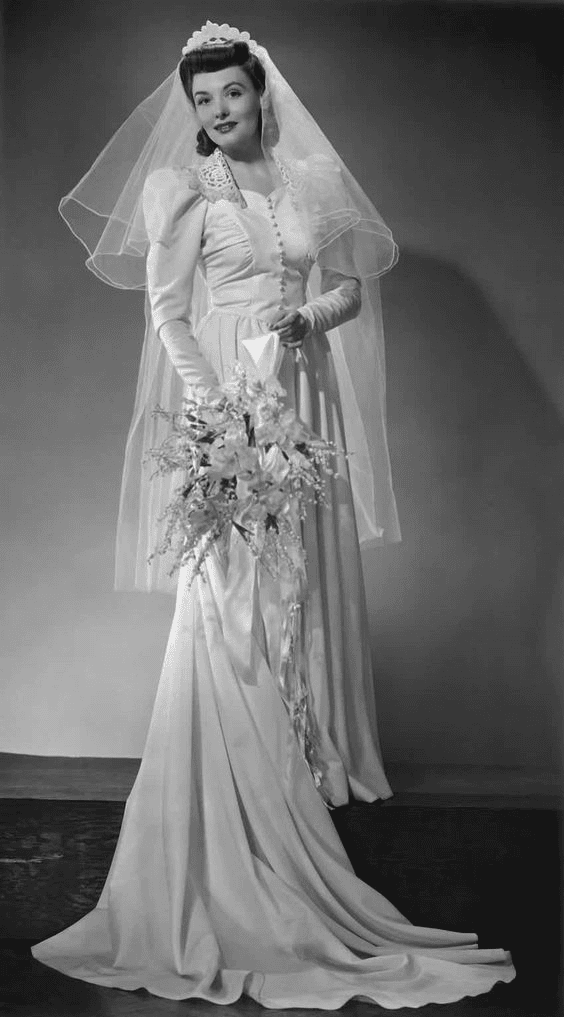
Credits: @littlethingscom / Pinterest
Key Takeaway
- 1950s wedding dresses are renowned for their romantic and elegant designs, characterized by full skirts, delicate lace, and sophisticated necklines, which continue to inspire modern bridal fashion.
- These gowns often feature intricate lace, luxurious fabrics, and various neckline styles such as sweetheart, high collar, and bateau, offering brides a blend of simplicity and sophistication.
- Iconic figures like Audrey Hepburn, Marilyn Monroe, Grace Kelly, and Elizabeth Taylor greatly influenced bridal fashion during the 1950s, setting trends that brides still admire and emulate today.
- The enduring charm of 1950s wedding dresses lies in their unique ability to blend historical beauty with timeless elegance, making them a popular choice for brides seeking a distinctive and memorable look.
Vintage Appeal of 1950s Wedding Dresses
Vintage wedding dresses from the 1950s exude a charm and elegance that modern brides find irresistible.
The decade saw the evolution of bridal gowns into the quintessential symbols of romance and beauty that we recognize today. Paired with heirloom diamond rings, these gowns reflect a timeless elegance that continues to captivate brides.
Definition and Charm of Vintage Wedding Dresses
Their classic designs and high-quality materials characterize vintage wedding dresses. They often feature intricate lace, delicate embroidery, and luxurious fabrics that exude a sense of timeless beauty.
The charm of these dresses lies in their ability to blend simplicity with sophistication, creating a look that is both understated and captivating.
The allure of vintage evening gowns also stems from their uniqueness. Each dress tells a story, reflecting the fashion trends and cultural influences of its time.
For brides seeking a distinctive and memorable look, vintage wedding dresses offer an opportunity to embrace the elegance and romance of a bygone era.
Evolution of Bridal Gowns in the 1950s
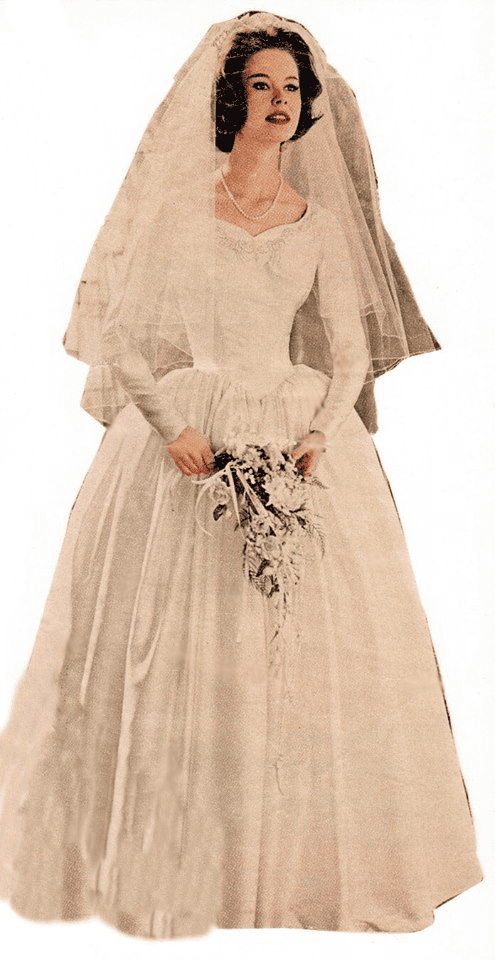
Credits: @mariselaspindol / Pinterest
The 1950s was a transformative decade for bridal fashion. After the austerity of the 1940s, the post-war era ushered in a new age of prosperity and glamour, which was reflected in wedding dress designs.
Bridal gowns of the 1950s evolved to emphasize femininity and opulence, with designers drawing inspiration from both Hollywood glamour and royal weddings.
Full skirts became a defining feature of 1950s wedding dresses, creating dramatic silhouettes that emphasized the bride’s waist and added a sense of grandeur.
The use of luxurious fabrics, such as silk, satin, and tulle, added to the gowns’ overall elegance.
Neckline styles also saw significant evolution, with the sweetheart, high collar, and bateau necklines becoming popular choices.
These variations allowed brides to express their individual style while adhering to the era’s fashion standards.
The evolution of bridal gowns in the 1950s was also influenced by iconic figures such as Audrey Hepburn. Their classic wedding dresses set trends and became the epitome of bridal fashion, inspiring countless brides to emulate their timeless elegance on their own big day.
The vintage appeal of 1950s wedding dresses continues to captivate modern brides, offering a perfect blend of historical charm and timeless elegance.
Whether choosing a genuine vintage gown or a vintage-inspired design, perhaps for a terracotta-themed wedding, brides can celebrate the enduring legacy of 1950s bridal fashion on their special day.
Design Features of 1950s Wedding Dresses
The 1950s introduced wedding dress designs that remain iconic and highly sought after. The distinct design features of 1950s wedding gowns are marked by their elegance, attention to detail, and timeless appeal.
These elements continue to inspire modern bridal fashion, creating a connection between past and present.
Here are some of the popular design features of 1950s wedding dresses:
Full Skirt
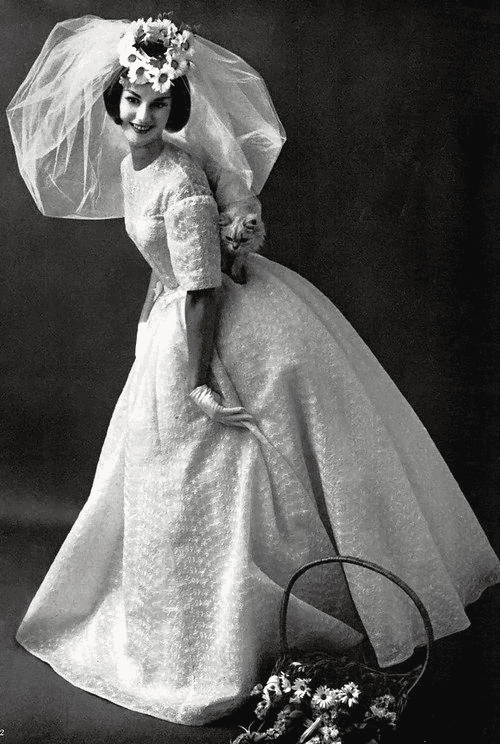
Credits: @bloglovin / Pinterest
One of the most defining features of 1950s wedding dresses is the full skirt. The full skirt was a hallmark of 1950s bridal fashion, representing both a return to opulence and a nod to traditional femininity.
The skirts often hung from a cinched waistline in an A-line shape, supported by voluminous petticoats that added to the dramatic effect, making them perfect for twirling on the dance floor.
Symbolizing grace and femininity, these skirts often included multiple layers of tulle and crinoline to create a voluminous and dramatic silhouette. Full skirts not only made a grand visual impact but also provided a flattering shape that accentuated the waist and flowed elegantly to the floor.
The tea length gown, another variation popular in this era, offered a playful yet sophisticated alternative, perfect for showcasing stylish footwear and adding a touch of retro charm.
Throughout the decade, the full skirt saw various adaptations, including the introduction of lighter materials like chiffon and tulle by the late 1950s. These fabrics helped soften the silhouette into a rounder ballgown style, making the dresses lighter and more ethereal.
Neckline Styles
Neckline designs in 1950s wedding dresses were varied and versatile, catering to different tastes and levels of modesty. Most common neckline Styles included:
Sweetheart Neckline
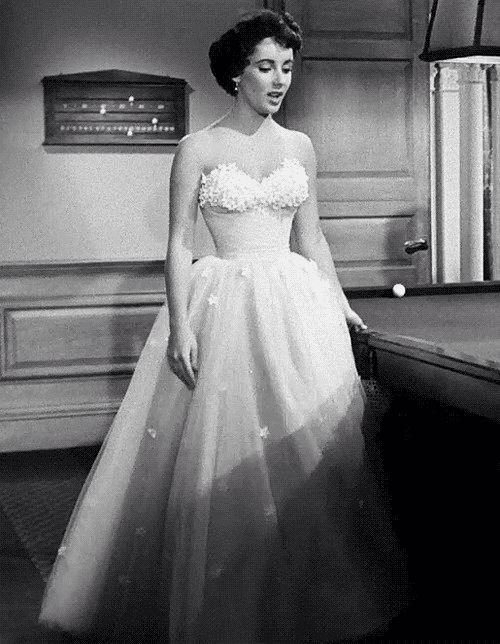
Credits: @dccba123 / Pinterest
A favorite among brides, the sweetheart neckline added a romantic and feminine touch to wedding gowns. It highlighted the décolletage while maintaining an elegant appearance.
High Collar
High-collared wedding dresses offered a more conservative yet sophisticated look. This style provided a sense of regality and was often adorned with lace or intricate embroidery.
Bateau Necklines
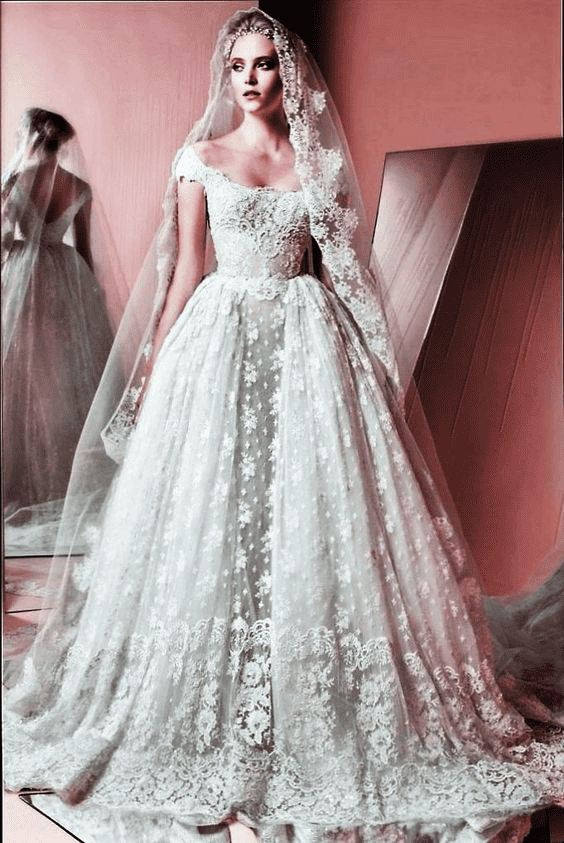
Credits: @rambla2008 / Pinterest
Bateau necklines, which extended to the shoulders, offered a modest yet stylish option. This neckline was particularly flattering for creating a balanced silhouette and was often seen in dresses with fitted bodices.
Illusion Neckline

Credits: @marthastewart / Pinterest
The illusion neckline, made with sheer fabric and embellished with lace or embroidery, added a touch of ethereal beauty. This style allowed for modest coverage while maintaining a delicate and feminine appeal.
Sleeve Types and Lengths
The mid-1950s introduced practical innovations in sleeve design, particularly for reception gowns.
Designers cleverly incorporated removable layers and detachable sleeves, allowing brides to transition from the formal ceremony look to a more relaxed style for the reception.
Initially, strapless gowns became fashionable, complemented by bolero jackets or detachable sleeves worn during the ceremony to maintain decorum.
Long Sleeves and Three-quarter Length Sleeves
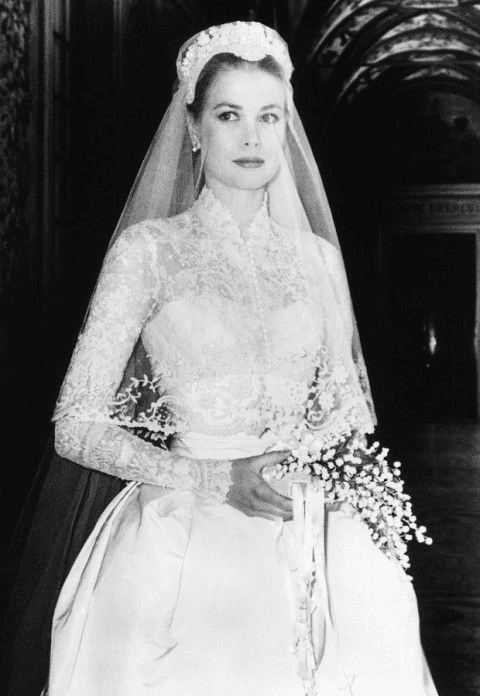
Credits: @marieclaireuk / Pinterest
Long sleeves and three-quarter length sleeves were highly favored in the 1950s for their elegance and modesty. These sleeve lengths provided a sophisticated look that was both stylish and practical, particularly for weddings held during cooler months.
Long sleeves often featured intricate lace or delicate embroidery, adding a layer of detail that complemented the gown’s overall design.
Three-quarter length sleeves, which ended just below the elbow, offered a balanced look that was both graceful and functional, allowing brides to showcase their gloves and jewelry.
Long sleeves also reflected the influence of notable fashion icons like Grace Kelly, whose regal wedding dress set a standard for bridal elegance.
The practicality of longer sleeves made them a popular choice for brides seeking warmth and coverage without compromising on style.
Short Sleeves and Sleeveless Options

Credits: @mapchic / Pinterest
Towards the late 1950s, bridal fashion began to embrace shorter sleeves and sleeveless designs, reflecting a shift towards more modern and daring styles.
Although initially controversial, short-sleeved and sleeveless gowns gained popularity, especially when paired with accessories like small jackets or shawls that could be removed as the celebration progressed.
This period marked a significant evolution in bridal sleeve design, integrating more flexibility and personalization into wedding attire.
Short sleeves added a youthful and fresh look to the bridal gown, making it an ideal choice for brides wanting a more relaxed yet elegant style.
Fabrics and Embellishments
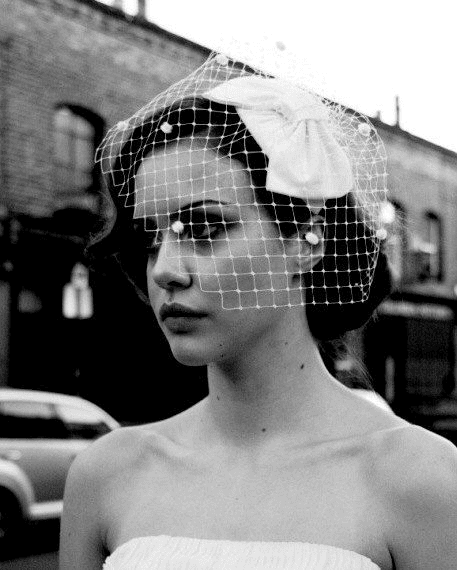
Credits: @mapchic / Pinterest
The choice of fabrics and embellishments in 1950s wedding dresses played a pivotal role in defining the era’s distinctive bridal fashion. The luxurious materials and detailed craftsmanship added to the elegance and timeless appeal of these gowns.
Lace and Embroidery
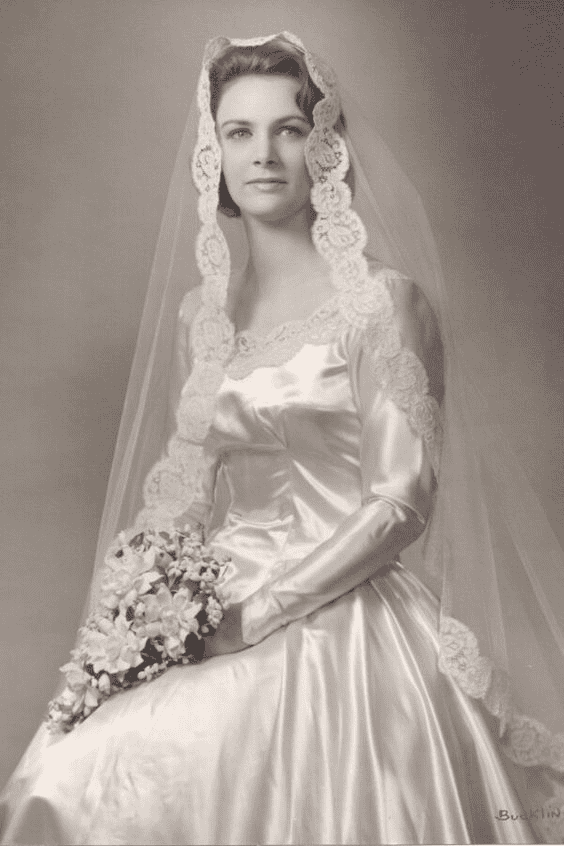
Credits: @melljayg / Pinterest
In the 1950s, lace was a key feature of wedding dresses, adorning bodices, sleeves, skirts, and veils with delicate and intricate patterns. Skilled artisans hand-stitched elaborate designs, making each dress unique.
Embroidered details, such as floral motifs, reflected the bride’s personal style, adding visual interest, texture, and depth to the overall aesthetic.
Tulle and Layers
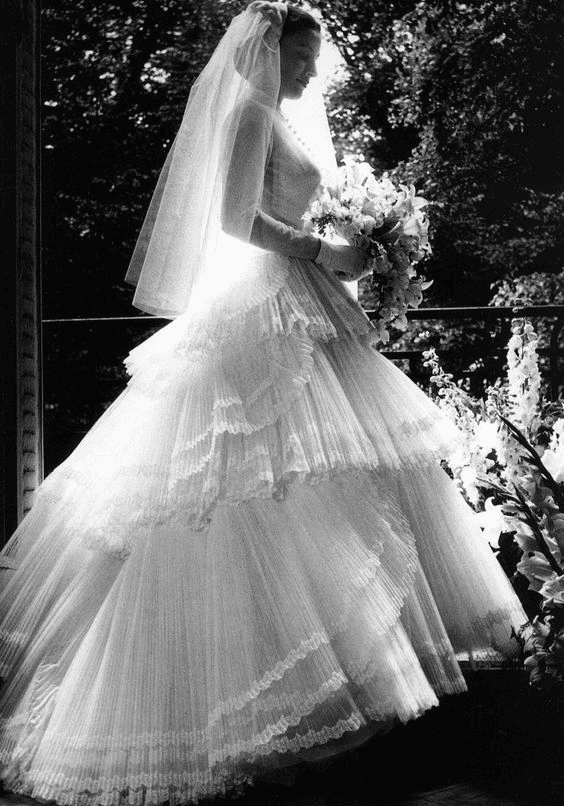
Credits: @popantique / Pinterest
Tulle was a key fabric in 1950s wedding dresses, especially for creating full skirts. Layers of tulle added volume and a dramatic silhouette, giving the dress a dreamy, ethereal quality.
Tulle was also used in veils and overlays, contributing to the overall texture and movement of the dress, while the combination of tulle and lace epitomized the elegance of 1950s bridal fashion.
Accessories and Completing the Look
Accessories were crucial in completing the 1950s bridal look, adding final touches that enhanced the gown’s elegance and reflected the bride’s personality.
Gloves

Credits: @LightInTheBox / Pinterest
White gloves were a quintessential accessory for 1950s brides, symbolizing purity and sophistication. They ranged from short, wrist-length gloves to longer opera gloves that extended above the elbow. Gloves added a touch of formality and refinement, perfectly complementing the overall bridal ensemble.
Hats

Credits: @sortra / Pinterest
Small hats or fascinators were popular headpieces for brides who wanted to add a unique vintage flair to their look. These hats often featured netting, feathers, or floral details, providing a stylish alternative to traditional veils.
Shoes

Credits: @weddingforward / Pinterest
High heels were the footwear of choice for most 1950s brides, enhancing their silhouette and adding an extra element of glamour. Ballerina flats were also a chic option, particularly for brides wearing tea-length gowns. Fashion shoes were often adorned with bows, pearls, or lace to match the gown’s detailing.
Veils

Credits: @tymburridge / Pinterest
Veils were an integral part of the 1950s bridal look, available in various lengths and styles to suit different preferences. Long, flowing veils added drama and elegance, often paired with full-skirted ballgowns. Shorter veils, such as birdcage veils, offered a more playful and vintage-inspired look, perfect for tea-length dresses.
Headpieces
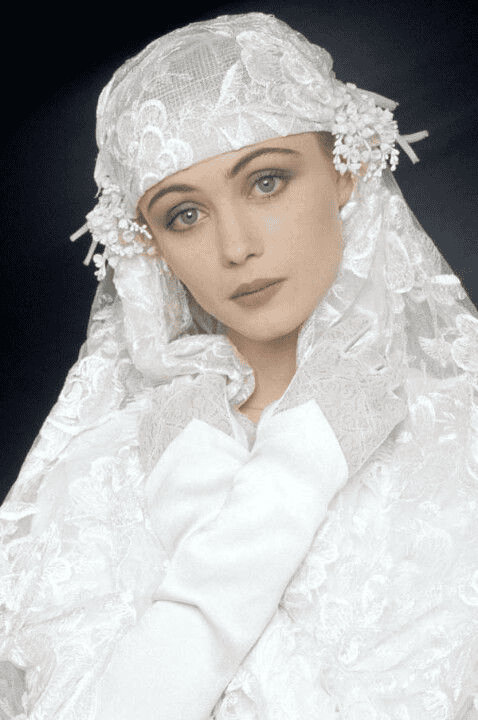
Credits: @DaisyDaYglO / Pinterest
Headpieces, such as tiaras, floral crowns, and jeweled combs, added an extra layer of glamour and sophistication. These accessories complemented the veil and gown, creating a cohesive and polished look. Tiaras, in particular, were favored for their regal appearance, inspired by royal weddings and Hollywood stars.
Inspiration from Hollywood Icons
The 1950s were a glamorous era, with Hollywood’s leading ladies setting trends that influenced bridal fashion for decades. Famous artists of the time also inspired elegant, timeless wedding styles.
Audrey Hepburn
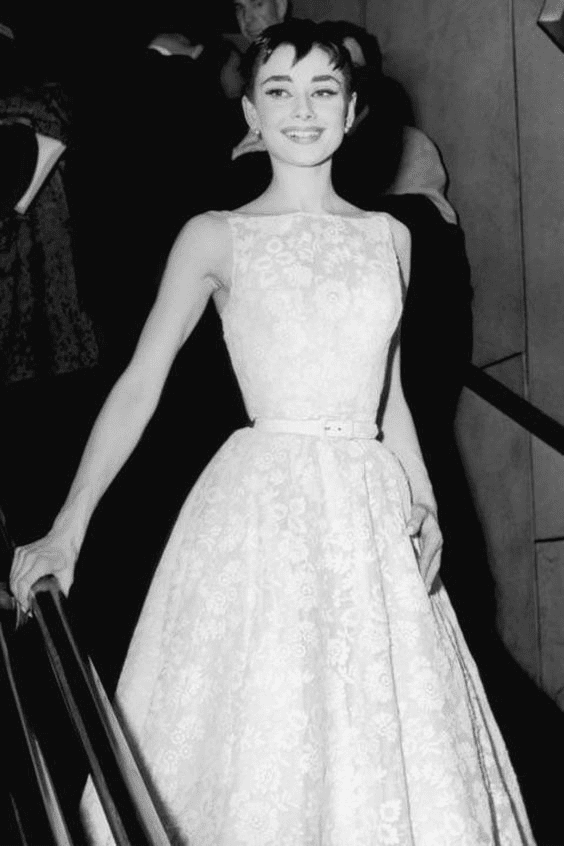
Credits: @etsy / Pinterest
Audrey Hepburn epitomized timeless elegance with her simple yet stunning tea-length gown in “Breakfast at Tiffany’s.”
Although this dress was not a wedding gown in the traditional sense, its classic design and chic appeal made it a popular choice for brides seeking a sophisticated and understated look.
The dress featured a fitted bodice, a full skirt, and delicate lace details, capturing the essence of 1950s bridal fashion. Hepburn’s style was all about grace and refinement, making her a lasting icon in the world of wedding dresses.
Marilyn Monroe
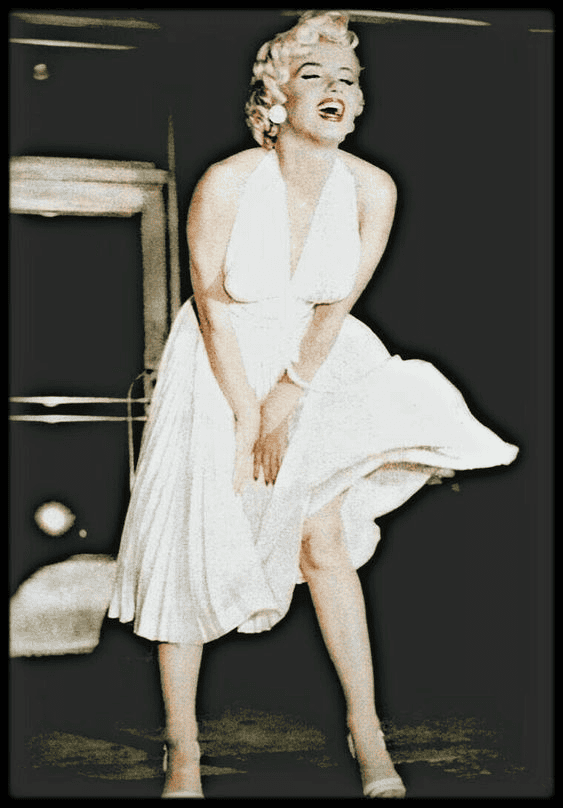
Credits: @vale15lucy / Pinterest
Marilyn Monroe embraced a bombshell silhouette with a flowing white lace gown in “The Seven Year Itch.” Known for her glamorous and sultry style, Monroe’s wedding look was both bold and elegant.
The gown featured a fitted bodice that accentuated her curves, while the lace overlay added a touch of romance and femininity.
Monroe’s choice of a dramatic, flowing gown reflected her larger-than-life persona, making her an enduring inspiration for brides who want to make a statement on their big day.
Grace Kelly and Elizabeth Taylor
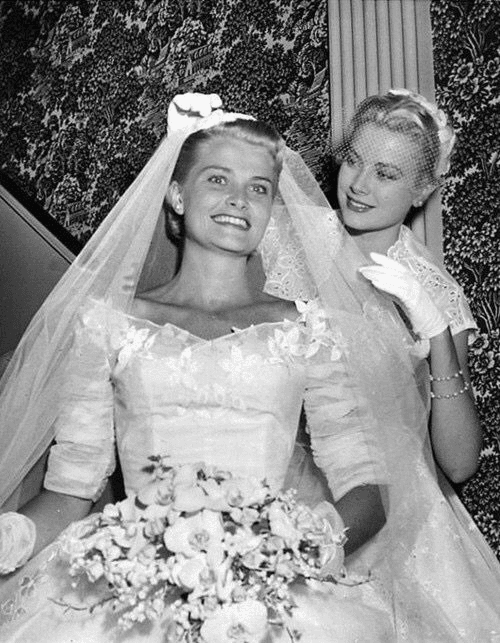
Credits: @ElanaPearl / Pinterest
Grace Kelly and Elizabeth Taylor both chose regal, full-skirted ballgowns for their weddings, which were heavily featured in the media and admired worldwide.
Grace Kelly’s wedding dress, designed by Helen Rose, is considered one of the most iconic bridal gowns of all time.
The gown featured a high collar, long sleeves, and a fitted bodice adorned with delicate lace and pearls. The full skirt was made of layers of tulle, creating a voluminous and regal silhouette.
Elizabeth Taylor, known for her multiple marriages and glamorous style, often chose extravagant wedding gowns that showcased her love for luxury and drama. Her most famous wedding dress, worn during her marriage to Conrad “Nicky” Hilton, was designed by MGM costume designer Helen Rose.
The gown featured a fitted bodice with intricate embroidery, a full skirt, and a dramatic veil, embodying the opulence and sophistication of Hollywood royalty. Kelly and Taylor’s wedding looks continue to inspire brides who desire a lavish and unforgettable bridal ensemble.
Wrap Up!
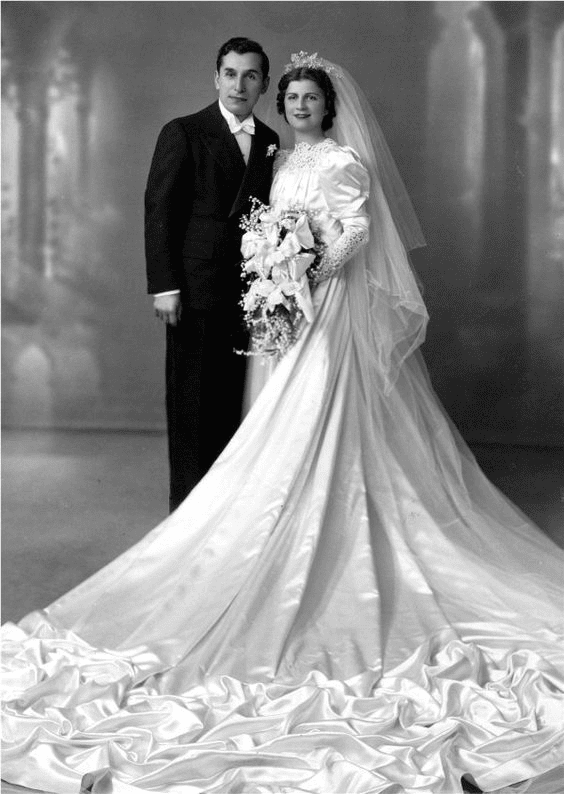
Credits: @ancestrycom / Pinterest
The enduring legacy and timeless elegance of 1950s wedding dress designs continue to captivate brides today. From the full skirts and delicate lace to the sophisticated necklines and the unique vintage accessories, these elements combine to create the perfect dress for a bride’s special day.
Whether inspired by Hollywood icons or the popular styles of past eras, 1950s vintage-inspired wedding dresses offer a timeless charm that remains unmatched in the world of bridal fashion.
